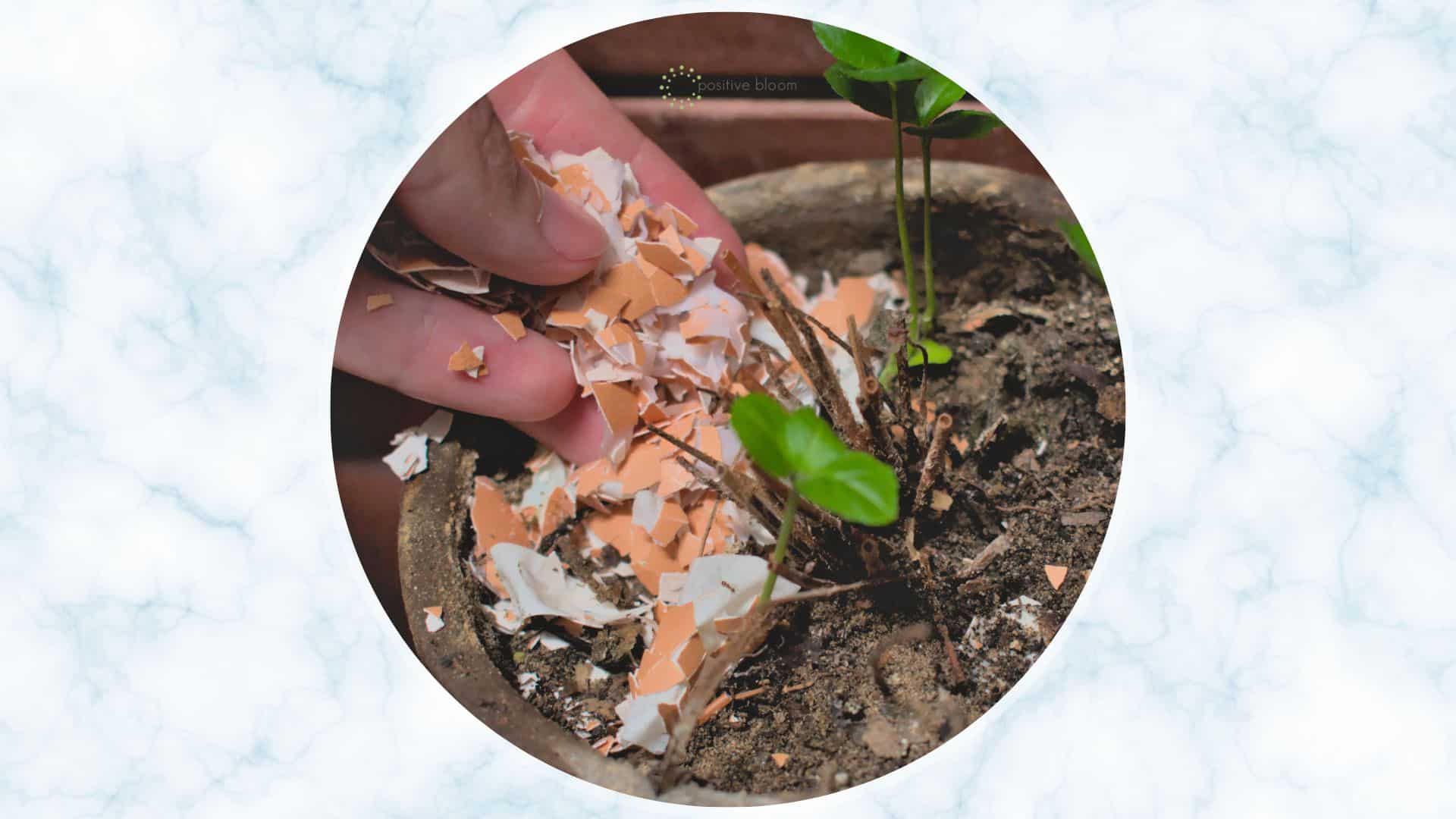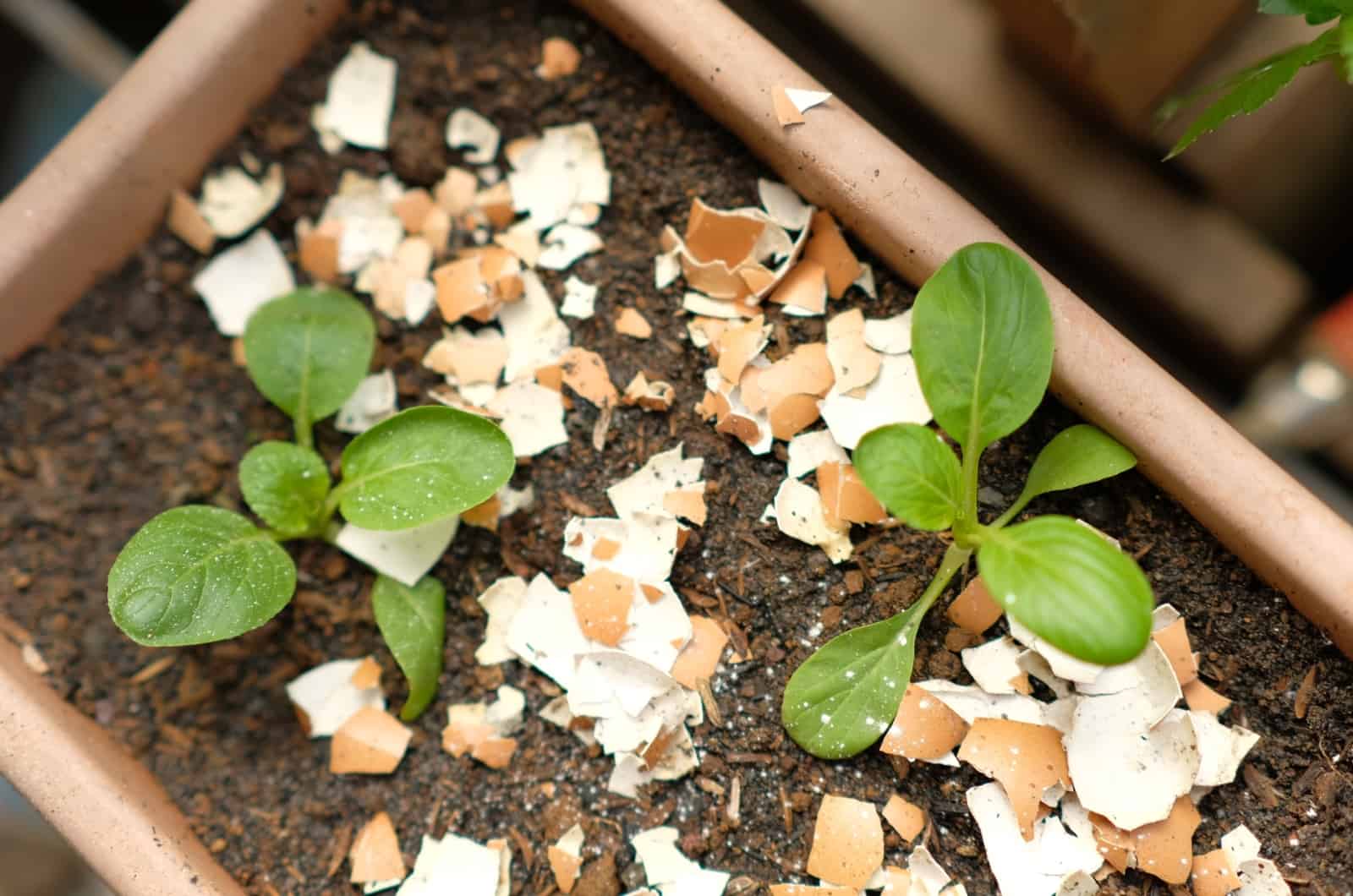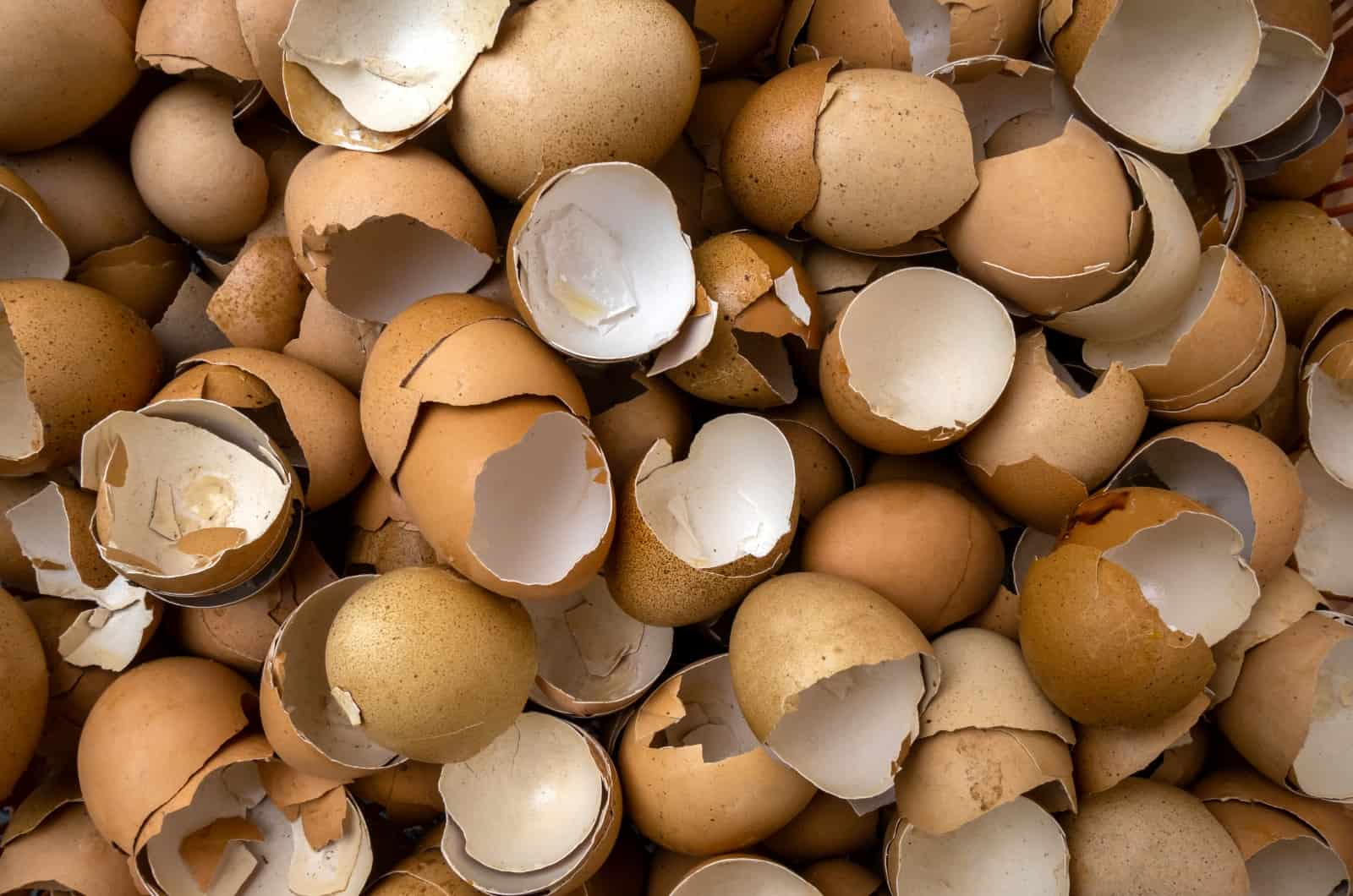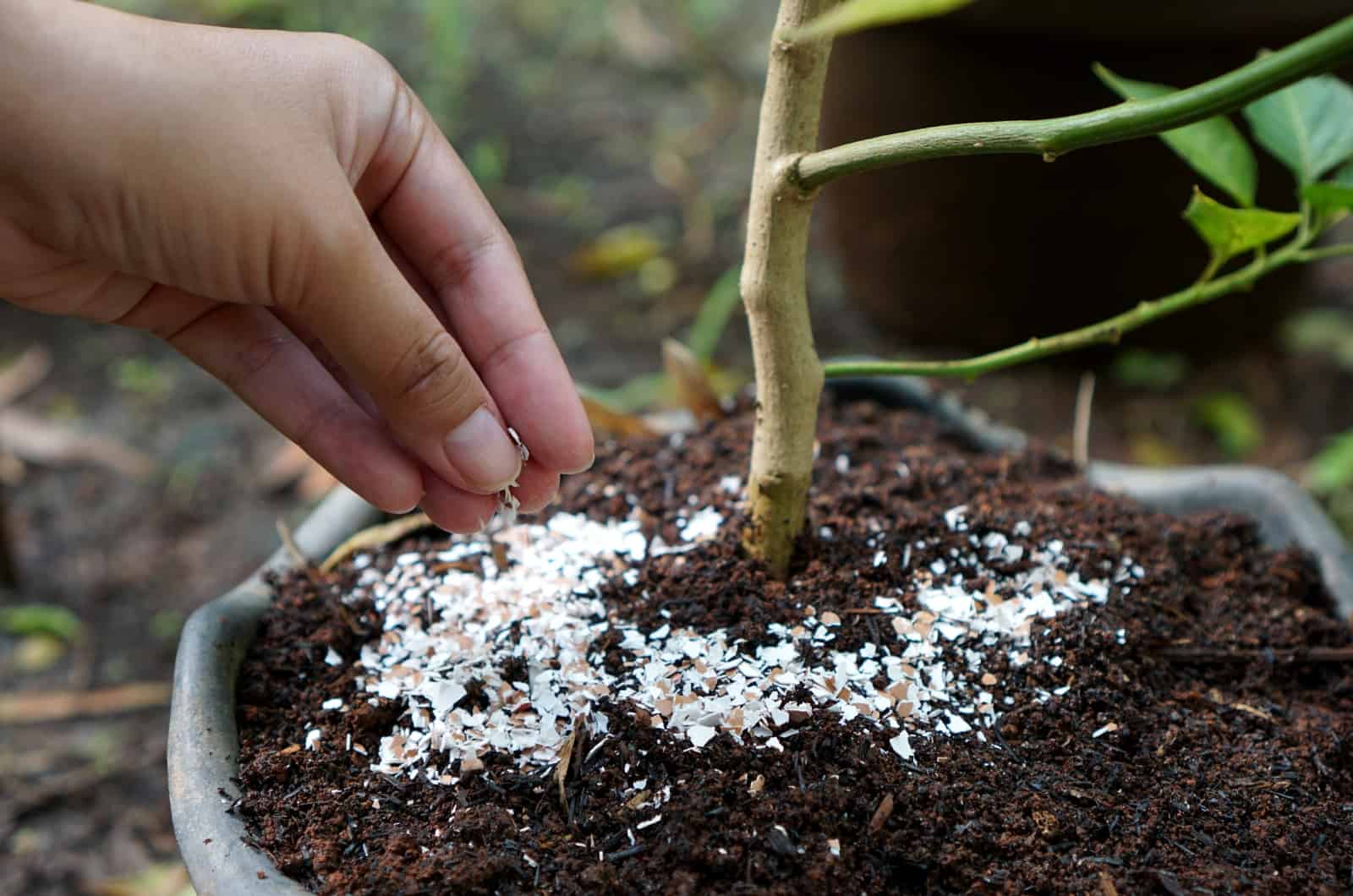Eggshells are an excellent source of calcium and phosphorus for all your plants, so don’t throw them away!
They can adsorb (adhere gas to their surface) phosphorus from the water, and you can use them as an alternative to phosphorus rich fertilizers.
However, calcination is sometimes not possible for small-scale growers since you need temperatures over 1400°F to do it, so we’ll stick to more traditional uses of eggshells. (1)
Instead, you can dehydrate and use them as a slow-release fertilizer, dilute them in water for an instant nutrient release, add them to the pots to improve drainage, etc.
You can also add them to your compost, use them as slug and snail repellents, or even crush them and feed them to the birds if you’d like.
And finally, we decided to include a recipe for making your own homemade eggshell fertilizer so that you can start using it immediately.
P.S. Reusing eggshells is an eco-friendly option as you reduce the amount of waste you create.
How To Use Eggshells In Potted Plants
Eggshells are an excellent organic source of calcium and phosphorus (although, the amount of this nutrient is rather small), and if you combine it with coffee grounds for your plants or some similar homemade fertilizer, you can have your houseplants thriving in no time.
The most common ways of using eggshells for container plants are applying the ground shells directly to the soil, diluting them in water and creating a fertilizer tea, placing entire eggshells into the pot to improve drainage, and using them as planters.
You can also add the eggshells to your compost and use them to repel snails and slugs.
We even discovered that you can feed the crushed eggshells to birds along with their regular food, but we’ll leave the benefits and drawbacks of this method to the experts to argue about.
Using Ground Eggshells
The easiest way to give your plants an additional boost is by sprinkling ground eggshells on top of the potting mix and slightly working it into the soil.
Then, water your plants thoroughly so that the fertilizer can work and the plant can absorb the nutrients it releases.
But don’t add too much or use this fertilizer too frequently since plants in general don’t require too much fertilizer, or rather, it’s a rarity for a calcium deficiency to occur in nature. (2)
Therefore, there’s no need to apply a lot of calcium if you don’t notice signs such as deformed young leaves, bushy appearance, and stunted growth. Testing the soil is always the best way to know which nutrient your plants need.
Furthermore, we can cause a hindrance in the absorption of calcium if we use high-potassium fertilizers, and vice versa. (3)
Therefore, apply the ground eggshells once or twice per year to your potted plants to avoid excess calcium and inadequate potassium uptake.
Using Eggshell Liquid Fertilizer
You can use eggshell fertilizer to make calcium water, and you can combine it with other homemade solutions, such as banana peel tea fertilizer, to give your plants an additional boost.
Making a liquid eggshell fertilizer is quite easy, and all you’ve got to do is pour about a gallon of boiling (or nearly boiling) water over 8-10 leftover eggshells and soak them for about a day or until the liquid reaches room temperature.
You can then strain it and use it for your potted plants. Once you finish, keep the solution at room temperature since plants don’t like cold showers.
In this video, you can see how easy it is to make eggshell water:
Using Eggshells To Improve Drainage
Another thing many growers love doing is adding eggshells to the bottom of containers to improve drainage.
All you need to do is crush the shells into pieces large enough to cover the holes in the bottom of the planter and spread them.
This method will make the potting soil drain faster, prevent compacting, and keep the growing medium from seeping out through the drainage holes.
Making Eggshell Planters
One thing we only recently started doing is planting our sunflower seeds in eggshells (although, you don’t have to be limited to these plants; it’s just what we had at the time).
Since eggshells break down over time, you can start various seeds in them and the calcium will give them an additional boost and keep them healthy.
Once the seeds germinate and you have young seedlings, you can transplant them into the ground or a container (with eggshells, yes).
You can even make planters for your succulents using eggshells, and here’s how to do it:
Step 1. Take a whole egg and crack it near the top. You can use a knife or a spoon to crack it and get the contents out.
Step 2. Clean the insides by rinsing the shell with boiling water and leaving it to dry out for 24-48 hours.
Step 3. Use a needle or something equally thin and pointed to “drill” a couple of holes in the bottom of the shell. These will mimic the function of drainage holes and prevent waterlogging.
Step 4. Fill ¾ of the eggshell with a seed starting mix (if you want to plant some seeds) or a succulent potting mix. Make sure to moisten the growing medium beforehand since it’ll make your job a lot easier.
Step 5. Create a hole in the substrate with your finger. After that, sow the seeds or plant your tiny succulent, and cover the holes with the mix.
Care for your succulents (or seeds) as you normally would, expose them to enough sunlight, water them when the medium is dry, and enjoy your unique planter.
Adding Eggshells To The Compost
Adding eggshells to your compost is an excellent way to enrich this black gold with more calcium without having to clean or grind them.
(Although, we do wash them since it breaks down the decomposition process and doesn’t attract scavengers).
If you have ground shells, you can compost them in that form as well.
Using Eggshells To Repel Snails And Slugs
Certain slimy pests can find their way into your container plants if you keep them outdoors, so there’s no harm in knowing that you can use eggshells to get rid of snails and slugs from your garden.
First, make sure to crush the eggshells into very tiny bits (but don’t grind them). Then, spread them all around your plant, creating a thick and wide layer. And if some shells end up on the leaves, let them be; they’re not hurting anyone.
Here’s how to use eggshells as a snail and slug repellant:
Homemade Eggshell Fertilizer
We talked about various uses for eggshell fertilizer, but we haven’t mentioned how to make one yourself.
Well, that’s rather simple, as all you’ve got to do is boil the eggshells for about 10-15 minutes and dry them either in the oven at 225°F for 20 minutes or by placing them outside under direct sunlight for a day or two.
Once the shells are completely dry, you can crush them in a blender, a coffee grinder, or use a pestle and mortar.
Then, you can add some vinegar or lemon juice to make the calcium more available, let the mixture dry out, and use them for your potted plants.
This can also be a homemade phosphorus fertilizer since eggshells contain a bit of phosphorus, although it’s the calcium that we primarily want from this material.
And in this video below, you can find more useful information for making eggshell fertilizer:
Final Thoughts
There are many ways of using eggshells in potted plants, such as adding the ground shells to the soil or diluting crushed ones in water to make a liquid fertilizer.
You can place the crushed eggshells in the bottom of the container to improve drainage or even turn it into a planter and grow your succulents and seeds in it.
Composting eggshells and using them to repel snails and slugs are other common ways of reusing this material.
Until next time!
[sp_easyaccordion id=”18378″]




